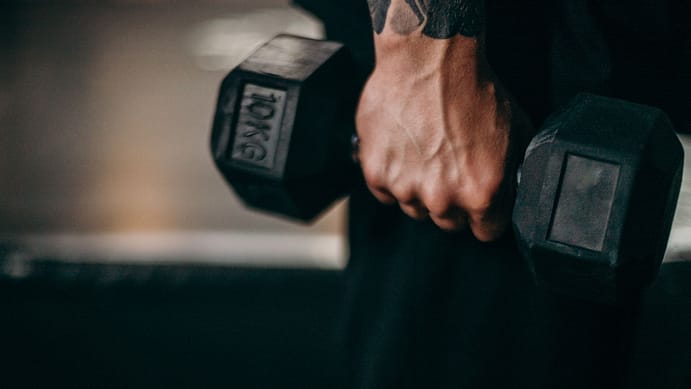Barbell squats and dumbbell squats are both great exercises for building lower body strength and muscle mass. While they are similar in nature, there are some key differences between the two.
Here are five differences between barbell squats and dumbbell squats: Equipment: The most obvious difference between the two is the equipment used. Stability: Barbell squats require more stability than dumbbell squats. Range of motion: With dumbbell squats, you have a greater range of motion than with barbell squats. Weight limitations: With barbell squats, you can typically lift more weight than with dumbbell squats. Difficulty: Barbell squats are generally considered to be more difficult than dumbbell squats.
Ultimately, whether you choose to do barbell squats or dumbbell squats will depend on your personal preferences and fitness goals.
For both exercises are effective for building lower body strength and muscle mass, and can be modified to suit your individual needs.
The barbell is usually placed on your shoulders behind your neck or in front of your chest.
On the other hand, dumbbell squats require only a pair of dumbbells of appropriate weight for your fitness level.
You hold one dumbbell in each hand and position them at your sides or on your shoulders, depending on the variation of the squat.
Dumbbell squats can be performed anywhere, as they do not require a squat rack or any other specialized equipment.

Stability.
In contrast, dumbbell squats require more stability because the weight is distributed on either side of your body.
This means that you must maintain balance and stability in two different areas of your body simultaneously.
This can be more challenging, as it requires more coordination and control of your body. Additionally, the weight of the dumbbells can shift slightly during the movement, which can make it more difficult to maintain proper form and balance.
Both barbell squats and dumbbell squats require stability, but barbell squats are generally considered to be easier to perform in terms of stability due to the even distribution of weight across your shoulders.
Range Of Motion
When performing a dumbbell squat, you can hold the dumbbells at your sides or rest them on your shoulders, which allows for a greater range of motion in the hips and legs.
This can help to engage the glutes and hamstrings more effectively than with barbell squats, which typically have a more limited range of motion due to the position of the barbell.
By targeting the glutes and hamstrings more effectively, dumbbell squats can help to build strength and muscle in these areas, which can improve overall lower body strength and help to prevent injury.
However, it is important to note that both barbell squats and dumbbell squats can be effective exercises for building lower body strength, and the best option will depend on your individual goals and fitness level.
Weight Limitation
With dumbbell squats, the weight is distributed on either side of your body, which can limit the amount of weight you can lift.
This is because the weight is limited by the strength of your arms and shoulders, as well as your ability to stabilize the dumbbells during the movement.
As a result, most people are able to lift less weight with dumbbell squats than with barbell squats.
It is worth noting that while barbell squats allow you to lift more weight, this does not necessarily mean they are a better exercise.
Both barbell squats and dumbbell squats can be effective for building lower body strength and improving overall fitness. The best option will depend on your individual goals and fitness level.
Difficulty
When performing barbell squats, the weight is distributed across your shoulders or chest, which requires you to maintain proper form and balance throughout the movement.
This can be challenging, especially if you are lifting heavy weights. Additionally, because you are lifting more weight with barbell squats than with dumbbell squats, you need to have a greater overall body strength to perform the exercise safely and effectively.
In contrast, dumbbell squats are generally considered to be easier because the weight is distributed on either side of your body.
This can make it easier to maintain balance and stability during the exercise. Additionally, because you are lifting less weight with dumbbell squats than with barbell squats, you may not need as much overall body strength to perform the exercise safely and effectively.
Both barbell squats and dumbbell squats can be effective exercises for building lower body strength and improving overall fitness.
However, barbell squats are generally considered to be more challenging due to the need for greater stability, balance, and overall body strength.
It is difficult to compare barbell squats and dumbbell squats as equals because they are different exercises that target the lower body in slightly different ways. However, here is a chart comparing the two exercises for various factors:
Factor |
Barbell Squats |
Dumbbell Squats |
|---|---|---|
| Range of Motion | Limited | Greater |
| Weight Limitations | Can lift more weight | Limited by arm strength |
| Difficulty | More challenging | Easier |
| Muscle Activation | Quads, glutes, hamstrings, lower back | Quads, glutes, hamstrings |
| Stabilization | Requires more stabilization and balance | Easier to stabilize |
| Equipment | Requires a barbell and weights | Requires dumbbells |
| Safety | Requires proper form and supervision | Can be performed safely with proper form |
| Variations | Back squats, front squats, overhead squats | Goblet squats, split squats, step-ups |
| Accessibility | May require a squat rack or gym equipment | Can be performed at home or in a gym |
| Range of Weights | Wide range of weight options | Limited range of weight options |
| Muscle Imbalance | Can expose muscle imbalances | Can help correct muscle imbalances |
| Core Activation | Engages core muscles for stabilization | Engages core muscles for stabilization |
| Joint Stress | Can place stress on hips and knees | Can be modified to reduce stress on joints |
| Mobility | Can require greater mobility and flexibility | Easier to modify for limited mobility |
| Time Efficiency | Can be time-efficient with heavier weights | May require more time with lighter weights |
| Skill Development | Requires skill development and practice | Easier to learn and perform |
| Unilateral Training | Can be difficult to perform unilaterally | Can be easily performed unilaterally |
| Functional Training | Can be more functional for sports and daily activities | Can be functional for sports and daily activities |
| Cost | May require gym membership or equipment purchase | Can be performed at home with inexpensive equipment |
| Intensity | Can be more intense with heavier weights | May require higher reps to achieve similar intensity |
| Muscle Isolation | Less potential for muscle isolation | Can be useful for isolating specific muscles |
| Foot Positioning | Can be challenging to adjust foot positioning | Easier to adjust foot positioning |
| Training Plateaus | Can help break through training plateaus | May require more variety to break through plateaus |
| Adaptability | Can be adapted to different body types | May require more adaptation for different body types |
| Growth Hormone Release | Can stimulate greater release of growth hormone | May not stimulate as much growth hormone release |
| Power Development | Can be useful for developing power | May not be as useful for power development |
| Athletic Performance | Can improve athletic performance for certain sports | Can improve athletic performance for certain sports |
| Cardiovascular Benefits | Can provide cardiovascular benefits with higher rep ranges | Can provide cardiovascular benefits with higher rep ranges |
It is very important to note that both exercises can be effective for building lower body strength and improving overall fitness.
The best option will depend on your individual goals, preferences, and fitness level. It is recommended to consult with a certified personal trainer to determine the best exercises for your individual needs.
Conclusion

Hey there, it’s Mike Rrsq, the Editor-in-Chief over at Jsquat.com, and I’m absolutely obsessed with all things squat fitness! I’ve been lucky enough to get some serious recognition for my work in this field. With a solid background in the fitness and wellness industry, I’ve been there right from the get-go, helping shape this website into what it is today.
You see, I’m not just the boss around here; I’m also a passionate contributor. I love sharing my insights through my articles, and trust me, they’re not your run-of-the-mill stuff. Each piece I write is a labor of love, filled with my expertise and real-world experience in the fitness universe. So, if you’re into fitness and looking for some inspiration, you’re in the right place!


